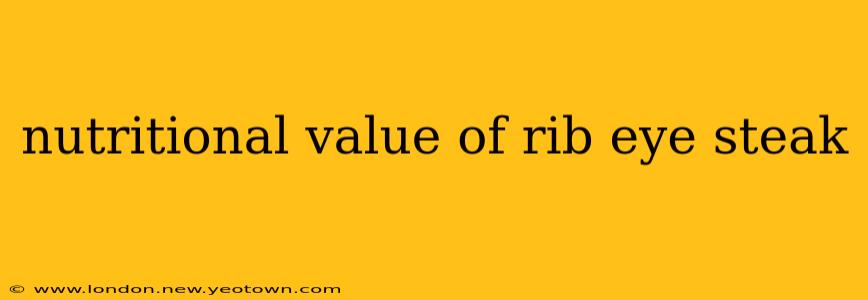Ah, the rib eye. Just the name conjures images of sizzling butter, perfectly seared crust, and that melt-in-your-mouth tenderness. But beyond the culinary delight, what's the nutritional story behind this popular cut of beef? Let's delve into the juicy details of a rib eye's nutritional value, exploring its benefits and drawbacks.
Our journey begins with a deep dive into the nutritional composition. A 3-ounce serving of a rib eye steak, cooked without added fat, packs a powerful punch. It's a significant source of high-quality protein, essential for building and repairing tissues, crucial for everything from muscle growth to hormone production. But it's not just about protein; rib eye is also rich in iron, vital for carrying oxygen throughout the body and preventing anemia. This iron is in the heme form, which is more readily absorbed than non-heme iron found in plant-based sources.
Is Rib Eye Steak Healthy?
This is a question that often sparks debate. The answer, as with most things in nutrition, is nuanced. While rib eye offers valuable nutrients, its high fat content is a significant factor to consider. It's important to remember that moderation is key. Enjoying a rib eye steak occasionally as part of a balanced diet shouldn't be cause for concern. However, making it a regular staple could lead to potential health issues if not balanced with other food choices.
How Many Calories Are in a Rib Eye Steak?
The calorie count of a rib eye varies based on the size of the steak and the cooking method. A 3-ounce serving can range from approximately 200 to 300 calories, but this number can easily climb with added fats during cooking, such as butter or oil. Therefore, opting for grilling or broiling is usually a healthier choice than pan-frying.
What Vitamins and Minerals Are in Rib Eye Steak?
Beyond protein and iron, rib eye steak is a good source of several B vitamins, including B12, niacin, and riboflavin. These vitamins are essential for energy production, nerve function, and red blood cell formation. It also contains smaller amounts of zinc, selenium, and phosphorus, all playing vital roles in various bodily processes.
What Are the Benefits of Eating Rib Eye Steak?
The benefits of eating rib eye, consumed in moderation, stem primarily from its high protein content and essential nutrients. This protein supports muscle growth and repair, crucial for athletes and individuals focusing on maintaining muscle mass. The readily available iron contributes to healthy energy levels and oxygen transport. Furthermore, the B vitamins contribute to overall metabolic function and nerve health.
What Are the Drawbacks of Eating Rib Eye Steak?
The primary drawback of rib eye is its high fat content, particularly saturated fat. High consumption of saturated fat has been linked to an increased risk of heart disease and high cholesterol. It's also relatively high in cholesterol, another factor that should be considered, especially for individuals with pre-existing heart conditions. Portion control and mindful consumption are vital to mitigating these risks.
Is Rib Eye Steak Good for Weight Loss?
Due to its high calorie and fat content, rib eye steak is not typically recommended for individuals actively trying to lose weight. While protein can be beneficial for satiety, the overall caloric density of rib eye makes it challenging to incorporate into a calorie-restricted diet effectively. Other leaner protein sources may be more appropriate for weight loss goals.
In conclusion, the rib eye steak offers a rich source of protein, iron, and B vitamins. However, its high fat and cholesterol content necessitate mindful consumption and balance within a broader healthy dietary framework. Enjoy it as an occasional treat, savoring its delicious flavor while remaining conscious of its nutritional profile. A balanced diet and regular exercise are key to maintaining overall health, regardless of occasional indulgences like a perfectly cooked rib eye.

